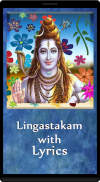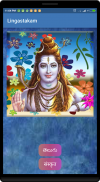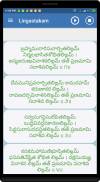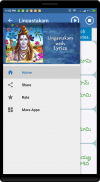







Lingastakam

คำอธิบายของLingastakam
A short introduction
Lingashtakam is a hymn in praise of Sri Siva, also called Maheswara, Rudra, Pasupati etc. The Linga is a symbol for Siva, just like Sankha and Chakra are symbolic of Sri Vishnu. Linga also means the gender of a being. We have Stree Linga (Female gender), Pumlinga (Male Gender) and Napumsaka Linga (literally non-male Gender, but meaning neutral gender). Linga has also become over the ages, a symbol of manliness, the erect phallus, and it is appropriate since He is the Adi Purusha. While Para Brahma is considered to be Nirguna, i.e. without any discernible attributes, once He/She/It decides to manifest in Saguna form (for reasons beyond our intelligence), we have Purusha (male) and Prakriti (Nature, considered to be feminine). And we have the Trinity (the creating, preserving and destroying aspects) of Devas and Devis, Brahma, Vishnu and Siva in the male aspects and Saraswati, Lakshmi and Parvati in their female aspects, their consorts.
แนะนำสั้น
Lingashtakam เป็นเพลงสวดสรรเสริญพระศิวะศรีเรียกว่า Maheswara, Rudra, Pasupati ฯลฯ องคชาติเป็นสัญลักษณ์พระศิวะเช่นเดียวกับบุคราและเป็นสัญลักษณ์ของศรีนารายณ์ องคชาติยังหมายถึงเพศของความเป็นอยู่ที่ เรามี Stree องคชาติ (เพศหญิง) Pumlinga (เพศชาย) และ Napumsaka องคชาติ (ตัวอักษรที่ไม่ใช่เพศชาย แต่ความหมายเป็นกลางเพศ) องคชาติยังเป็นเวลานานซึ่งเป็นสัญลักษณ์ของความเป็นลูกผู้ชาย, ลึงค์แข็งตัวและมันมีความเหมาะสมตั้งแต่เขาเป็น Adi Purusha ในขณะที่พาราพระพรหมจะถือเป็น Nirguna คือไม่มีแอตทริบิวต์มองเห็นใด ๆ เมื่อเขา / เธอ / มันตัดสินใจที่จะแสดงให้เห็นในรูปแบบ Saguna (ด้วยเหตุผลที่นอกเหนือหน่วยสืบราชการลับของเรา) เรามี Purusha (ชาย) และ Prakriti (ธรรมชาติถือว่าเป็นผู้หญิง ) และเรามีทรินิตี้ (การสร้าง, การรักษาและการทำลายด้าน) ของอมรและ Devis พระพรหมพระวิษณุและพระศิวะในด้านชายและสรัสวดีพระลักษมีปาราวตีในด้านเพศหญิงของพวกเขาอยู่ไกลโพ้นของพวกเขา

























